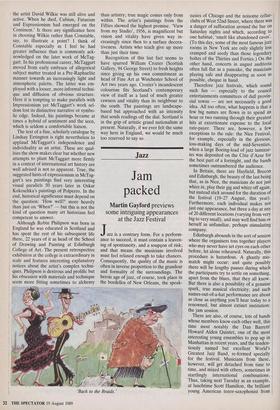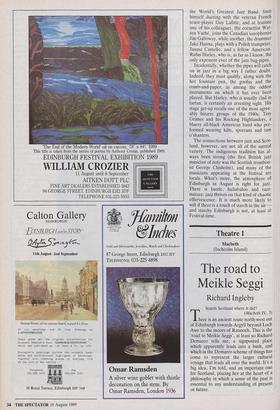Jazz
Jam packed
Martin Gayford previews some intriguing appearances at the Jazz Festival
Jazz is a contrary form. For a perform- ance to succeed, it must contain a leaven- ing of spontaneity, and a soupcon of risk; and that means the musicians involved must feel relaxed enough to take chances. Consequently, the quality of the music is often in inverse proportion to the grandeur and formality of the surroundings. The heroic age of jazz, of course, took place in the bordellos of New Orleans, the speak-
`Back to the Braids.'
easies of Chicago and the noisome cellar- clubs of West 52nd Street, where there was a danger of suffocation around the bar on Saturday nights and which, according to one habitué, 'smelt like abandoned caves'. (To this day, some of the most famous jazz rooms in New York are only slightly less cramped and seedy than those legendary boites of the Thirties and Forties.) On the other hand, concerts in august auditoria often fall flat as a pancake, the musicians playing safe and disappearing as soon as possible, cheque in hand. Therefore jazz festivals, which sound such fun — especially to the council entertainments committees of dull provin- cial towns — are not necessarily a good idea. All too often, what happens is that a few big names are flown in to spend an hour or two running through their greatest hits at extortionate expense to the local rate-payer. There are, however, a few exceptions to the rule: the Nice Festival, for example, especially in the glorious, loss-making days of the mid-Seventies, when a large Boeing-load of jazz luminar- ies was deposited on the Cote d'Azur for the best part of a fortnight, and the bands sometimes outnumbered the audience.
In Britain, there are Hayfield, Brecon and Edinburgh, the beauty of the last being that, as in Nice, the musicians do not just whizz in, play their gig and whizz off again, but instead stick around for the duration of the festival (19-27 August, this year). Furthermore, each individual makes not just one appearance, but three a day at any of 20 different locations (varying from very big to very small), and may well find him or herself in unfamiliar, perhaps stimulating company.
Edinburgh abounds in the sort of session where the organisers toss together players who may never have set eyes on each other before, let alone rehearsed. Naturally, this procedure is hazardous. A ghastly mis- match might occur; and quite possibly there will be lengthy pauses during which the participants try to settle on something, apart from the blues, that they all know. But there is also a possibility of a genuine spark, true musical electricity; and such names-out-of-a-hat performance are about as close as anything you'll hear today to a renowned, but almost extinct institution: the jam session.
There are also, of course, lots of bands whose members know each other well, this time most notably the Dan Barrett/ Howard Alden Quintet, one of the most interesting young ensembles to pop up in Manhattan in recent years, and the tenden- tiously named but excellent World's Greatest Jazz Band, re-formed specially for the festival. Musicians from these, however, will get detached from time to time, and mixed with others, sometimes in startlingly international combinations. Thus, taking next Tuesday as an example, at lunchtime Scott Hamilton, the brilliant young American tenor-saxophonist from the World's Greatest Jazz Band, finds himself dueting with the veteran French tenor-player Guy Lafitte; and at teatime one of his colleagues, the cornettist War- ren Vache, joins the Canadian saxophonist Jim Galloway, while another, the drummer Jake Hanna, plays with a Polish trumpeter, Janusz Camello, and a fellow American, Rufus Harley, who is, as far as I know, the only exponent ever of the jazz bag-pipes.
Incidentally, whether the pipes will catch on in jazz in a big way I rather doubt. Indeed, they must qualify, along with the hot fountain pen, the goofus and the comb-and-paper, as among the oddest instruments on which it has ever been played. But Harley, who is usually clad in tartan, is certainly an arresting sight. His stage get-up recalls one of the most agree- ably bizarre groups of the 1940s: Tiny Grimes and his Rocking Highlanders, a bluesy all-black American band who per- formed wearing kilts, sporrans and tam o'shanters.
The connections between jazz and Scot- land, however, are not all of the surreal variety. The indigenous tradition has al- ways been strong (the first British jazz musician of note was the Scottish trombon- ist George Chisholm), and many of the musicians appearing at the festival are locals. What's more, the atmosphere of Edinburgh in August is right for jazz. There is bustle, hullabaloo and razz- matazz; jazz thrives on that kind of chaotic effervescence. It is much more likely to wilt if there is a touch of starch in the air — and starchy Edinburgh is not, at least at Festival-time.



















































 Previous page
Previous page